Deck 9: Weather Patterns
Question
Question
Question
Question
Question
Question
Question
Question
Question
Question
Question
Question
Question
Question
Question
Question
Question
Question
Question
Question
Question
Question
Question
Question
Question
Question
Question
Question
Question
Question
Question
Question
Question
Question
Question
Question
Question
Question
Question
Question
Question
Question
Question
Question
Question
Question
Question
Question
Question
Question
Question
Question
Question
Question
Question
Question
Question
Question
Question
Question
Question
Question
Question
Question
Question
Question
Question
Question
Question
Question
Question
Question
Question
Question
Question
Question
Question
Question
Question
Question

Unlock Deck
Sign up to unlock the cards in this deck!
Unlock Deck
Unlock Deck
1/114
Play
Full screen (f)
Deck 9: Weather Patterns
1
Refer to the diagram of a mature wave cyclone.
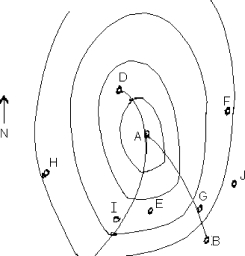
Line A- D probably represents:
A) an occluded front.
B) a stationary front.
C) a warm front.
D) a cold front.

Line A- D probably represents:
A) an occluded front.
B) a stationary front.
C) a warm front.
D) a cold front.
A
2
Middle- latitude cyclones in the Northern Hemisphere:
A) rotate counterclockwise.
B) travel from east to west.
C) are large high- pressure systems.
D) have cold fronts but not warm fronts.
A) rotate counterclockwise.
B) travel from east to west.
C) are large high- pressure systems.
D) have cold fronts but not warm fronts.
A
3
The approximate lifetime of a wave cyclone is:
A) 1 - 2 days.
B) 10 - 24 hours.
C) a month.
D) a few days to a week.
E) 10 - 14 days.
A) 1 - 2 days.
B) 10 - 24 hours.
C) a month.
D) a few days to a week.
E) 10 - 14 days.
D
4
A wind shift in a clockwise direction, as from south to west, is termed wind shift.
A) veering
B) anticyclonic
C) frontal
D) backing
A) veering
B) anticyclonic
C) frontal
D) backing

Unlock Deck
Unlock for access to all 114 flashcards in this deck.
Unlock Deck
k this deck
5
The cloud type most frequently associated with a cold front is:
A) status.
B) cirrocumulus.
C) altocumulus.
D) cirrus.
E) cumulonimbus.
A) status.
B) cirrocumulus.
C) altocumulus.
D) cirrus.
E) cumulonimbus.

Unlock Deck
Unlock for access to all 114 flashcards in this deck.
Unlock Deck
k this deck
6
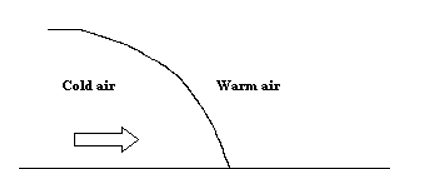
Which of the following air masses is most likely to be the cold air in the diagram above?
A) mP
B) cP
C) mT
D) cT

Unlock Deck
Unlock for access to all 114 flashcards in this deck.
Unlock Deck
k this deck
7
In the United States, the air mass most commonly found at the back of a cold front is:
A) mP.
B) cT.
C) mT.
D) cP.
A) mP.
B) cT.
C) mT.
D) cP.

Unlock Deck
Unlock for access to all 114 flashcards in this deck.
Unlock Deck
k this deck
8
The arrival of a cold front brings:
A) higher temperatures.
B) cumulonimbus clouds.
C) mild weather.
D) stationary winds.
E) gentle rains.
A) higher temperatures.
B) cumulonimbus clouds.
C) mild weather.
D) stationary winds.
E) gentle rains.

Unlock Deck
Unlock for access to all 114 flashcards in this deck.
Unlock Deck
k this deck
9
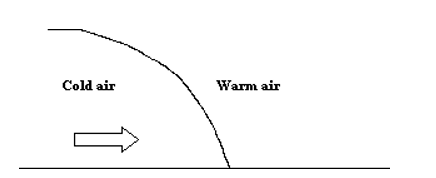
-The type of weather most frequently associated with the front shown on the diagram above is:
A) blizzards.
B) clear skies.
C) steady, gentle rainfall.
D) thunderstorms and other severe weather.

Unlock Deck
Unlock for access to all 114 flashcards in this deck.
Unlock Deck
k this deck
10
An approaching wave cyclone would be indicated by a________ barometer reading.
A) slowly rising
B) high
C) variable, rising then falling
D) very low
E) rapidly falling
A) slowly rising
B) high
C) variable, rising then falling
D) very low
E) rapidly falling

Unlock Deck
Unlock for access to all 114 flashcards in this deck.
Unlock Deck
k this deck
11
Rain long foretold, long last; short notice, soon past. The FIRST FIVE words of this weather proverb:
A) refer to the formation of cumulonimbus clouds.
B) have no basis in fact.
C) refer to a cold front.
D) refer to a warm front.
E) refer to an anticyclone.
A) refer to the formation of cumulonimbus clouds.
B) have no basis in fact.
C) refer to a cold front.
D) refer to a warm front.
E) refer to an anticyclone.

Unlock Deck
Unlock for access to all 114 flashcards in this deck.
Unlock Deck
k this deck
12
A midlatitude cyclone forms in western Canada, and very rapidly moves through the Dakotas and passes over the Great Lakes region, bringing very cold temperatures with it. This storm would probably be called a(an):
A) Nor'easter.
B) Alberta Clipper.
C) Siberian Express.
D) Panhandle Hook.
A) Nor'easter.
B) Alberta Clipper.
C) Siberian Express.
D) Panhandle Hook.

Unlock Deck
Unlock for access to all 114 flashcards in this deck.
Unlock Deck
k this deck
13
What is the cause- and- effect relationship between the pattern of upper- level winds and surface low- and high- pressure systems?
A) There is no strong or consistent relationship.
B) Surface lows decrease upper level wind speeds, surface highs increase them.
C) Surface systems depend primarily on wind speeds at upper levels.
D) Upper level wind patterns strongly control the origin and development of surface systems.
E) Surface systems control the upper level wind patterns.
A) There is no strong or consistent relationship.
B) Surface lows decrease upper level wind speeds, surface highs increase them.
C) Surface systems depend primarily on wind speeds at upper levels.
D) Upper level wind patterns strongly control the origin and development of surface systems.
E) Surface systems control the upper level wind patterns.

Unlock Deck
Unlock for access to all 114 flashcards in this deck.
Unlock Deck
k this deck
14
A trough aloft is generally associated with:
A) cyclonic flow at the surface.
B) anticyclonic flow at the surface.
C) convergence of the jet steam.
D) clear skies.
A) cyclonic flow at the surface.
B) anticyclonic flow at the surface.
C) convergence of the jet steam.
D) clear skies.

Unlock Deck
Unlock for access to all 114 flashcards in this deck.
Unlock Deck
k this deck
15
A blocking high is caused by:
A) a persistent anticyclone.
B) a cutoff low.
C) an occluded front.
D) divergence in the upper atmosphere.
A) a persistent anticyclone.
B) a cutoff low.
C) an occluded front.
D) divergence in the upper atmosphere.

Unlock Deck
Unlock for access to all 114 flashcards in this deck.
Unlock Deck
k this deck
16
A dryline causes uplift to occur because:
A) the lifted air mass is moister than the intruding air mass.
B) the intruding air mass has the same low humidity as the lifted air mass.
C) the intruding air mass is colder and more humid than the lifted air mass.
D) the lifted air mass is dryer than the intruding air mass.
A) the lifted air mass is moister than the intruding air mass.
B) the intruding air mass has the same low humidity as the lifted air mass.
C) the intruding air mass is colder and more humid than the lifted air mass.
D) the lifted air mass is dryer than the intruding air mass.

Unlock Deck
Unlock for access to all 114 flashcards in this deck.
Unlock Deck
k this deck
17
Surface cyclones move at a speed that is:
A) one- quarter to one- half the speed of the winds at the 500- mb pressure level.
B) five times greater than the speed of a cold front.
C) a product of the surface pressure gradient force.
D) determined by the jet stream.
A) one- quarter to one- half the speed of the winds at the 500- mb pressure level.
B) five times greater than the speed of a cold front.
C) a product of the surface pressure gradient force.
D) determined by the jet stream.

Unlock Deck
Unlock for access to all 114 flashcards in this deck.
Unlock Deck
k this deck
18
After a cold front passes, which of these does NOT usually occur?
A) clearing skies
B) wind direction shift
C) falling barometer
D) marked temperature drop
A) clearing skies
B) wind direction shift
C) falling barometer
D) marked temperature drop

Unlock Deck
Unlock for access to all 114 flashcards in this deck.
Unlock Deck
k this deck
19
As a warm front approaches, which progression of clouds are you most likely to see?
A) cirrus, cirrostratus, altostratus, nimbostratus
B) altostratus, cirrostratus, stratus, cumulonimbus
C) cirrus, cumulonimbus
D) cirrocumulus, cirrus, nimbostratus, stratus
A) cirrus, cirrostratus, altostratus, nimbostratus
B) altostratus, cirrostratus, stratus, cumulonimbus
C) cirrus, cumulonimbus
D) cirrocumulus, cirrus, nimbostratus, stratus

Unlock Deck
Unlock for access to all 114 flashcards in this deck.
Unlock Deck
k this deck
20
When speed divergence occurs in the upper atmosphere, what effect does it have on cyclogenesis?
A) It inhibits cyclogenesis by preventing cyclonic flow.
B) It greatly enhances cyclogenesis by increasing convergence on the surface below.
C) It has no impact whatsoever on the formation of mid- latitude cyclones.
D) It can either inhibit or enhance cyclogenesis, depending on the surface air temperature.
A) It inhibits cyclogenesis by preventing cyclonic flow.
B) It greatly enhances cyclogenesis by increasing convergence on the surface below.
C) It has no impact whatsoever on the formation of mid- latitude cyclones.
D) It can either inhibit or enhance cyclogenesis, depending on the surface air temperature.

Unlock Deck
Unlock for access to all 114 flashcards in this deck.
Unlock Deck
k this deck
21
Middle- latitude anticyclones in the Northern Hemisphere:
A) rotate clockwise.
B) are large low- pressure systems.
C) travel from east to west.
D) have cold fronts but not warm fronts.
A) rotate clockwise.
B) are large low- pressure systems.
C) travel from east to west.
D) have cold fronts but not warm fronts.

Unlock Deck
Unlock for access to all 114 flashcards in this deck.
Unlock Deck
k this deck
22
Which of these is common to both cold and warm fronts?
A) decreasing precipitation rates
B) light to calm winds
C) lifting of warm air over cold
D) steady barometer readings
E) divergence of surface winds
A) decreasing precipitation rates
B) light to calm winds
C) lifting of warm air over cold
D) steady barometer readings
E) divergence of surface winds

Unlock Deck
Unlock for access to all 114 flashcards in this deck.
Unlock Deck
k this deck
23
A ridge aloft is generally associated with:
A) anticyclonic flow at the surface.
B) stormy weather.
C) cyclonic flow at the surface.
D) divergence of the jet stream.
A) anticyclonic flow at the surface.
B) stormy weather.
C) cyclonic flow at the surface.
D) divergence of the jet stream.

Unlock Deck
Unlock for access to all 114 flashcards in this deck.
Unlock Deck
k this deck
24
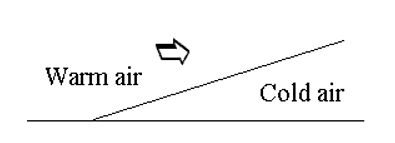
-Which of the following best represents the wind direction at point H?
A) SE
B) E
C) NW
D) NE
E) SW

Unlock Deck
Unlock for access to all 114 flashcards in this deck.
Unlock Deck
k this deck
25

-Refer to the diagram of a front shown above. If the warm air at the back is stable, what kind of cloud is most likely to form and produce precipitation in association with the front?
A) altocumulus
B) cumulonimbus
C) nimbostratus
D) cirrus

Unlock Deck
Unlock for access to all 114 flashcards in this deck.
Unlock Deck
k this deck
26
The clear skies that separate the head of the comma from the tail in a mid- latitude cyclone are associated with what feature of the storm?
A) the warm conveyor belt
B) the mT air mass
C) the cold conveyor belt
D) the dry slot
A) the warm conveyor belt
B) the mT air mass
C) the cold conveyor belt
D) the dry slot

Unlock Deck
Unlock for access to all 114 flashcards in this deck.
Unlock Deck
k this deck
27
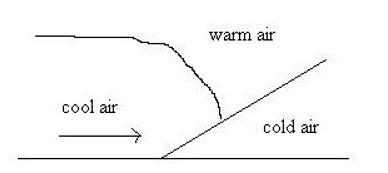
-The type of front represented in the diagram above is a:
A) stationary front.
B) cold front.
C) warm- type occluded front.
D) cold- type occluded front.

Unlock Deck
Unlock for access to all 114 flashcards in this deck.
Unlock Deck
k this deck
28
The lifting of air and the resulting formation of clouds and rain is more gentle (gradual) for a:
A) divergence zone.
B) warm front.
C) mesocyclone.
D) cold front.
E) occluded front.
A) divergence zone.
B) warm front.
C) mesocyclone.
D) cold front.
E) occluded front.

Unlock Deck
Unlock for access to all 114 flashcards in this deck.
Unlock Deck
k this deck
29
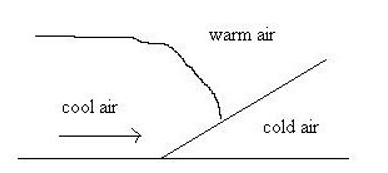
-The type of front shown on the diagram above is:
A) an occluded front.
B) a cold front.
C) a stationary front.
D) a warm front.

Unlock Deck
Unlock for access to all 114 flashcards in this deck.
Unlock Deck
k this deck
30
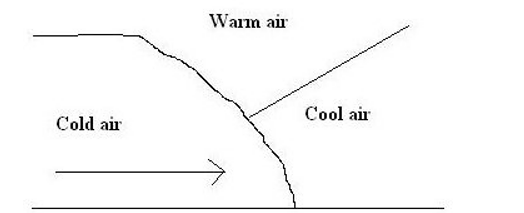
-The type of front represented in the diagram above is a:
A) cold- type occluded front.
B) stationary front.
C) warm- type occluded front.
D) warm front.

Unlock Deck
Unlock for access to all 114 flashcards in this deck.
Unlock Deck
k this deck
31
If you were 200 kilometers ahead of the surface position of a warm front, you would find the frontal surface at a height of ______km overhead.
A) 2.5
B) 0.5
C) 1.5
D) 2
E) 1
A) 2.5
B) 0.5
C) 1.5
D) 2
E) 1

Unlock Deck
Unlock for access to all 114 flashcards in this deck.
Unlock Deck
k this deck
32
A low- flying aircraft heading from point J to point H would most likely experience which of the following changes in wind direction?
A) N to S to W
B) SE to SW to NW
C) NE to N to NW
D) SW to SE to NE
E) E to W to NE
A) N to S to W
B) SE to SW to NW
C) NE to N to NW
D) SW to SE to NE
E) E to W to NE

Unlock Deck
Unlock for access to all 114 flashcards in this deck.
Unlock Deck
k this deck
33
The glaze (or freezing rain) that sometimes forms in association with warm fronts occurs when:
A) rain falls during the day and freezes at night.
B) rain freezes as it falls through the air.
C) rain strikes a very cold surface and freezes directly to it.
D) snow melts against a warm surface and later freezes.
A) rain falls during the day and freezes at night.
B) rain freezes as it falls through the air.
C) rain strikes a very cold surface and freezes directly to it.
D) snow melts against a warm surface and later freezes.

Unlock Deck
Unlock for access to all 114 flashcards in this deck.
Unlock Deck
k this deck
34
The modern view of cyclogenesis, updated from traditional polar front theory to provide a better three- dimensional view, is known as:
A) the wave model.
B) the Bjerknes model.
C) the triphasic model.
D) the conveyor belt model.
A) the wave model.
B) the Bjerknes model.
C) the triphasic model.
D) the conveyor belt model.

Unlock Deck
Unlock for access to all 114 flashcards in this deck.
Unlock Deck
k this deck
35
The width or horizontal extent of a typical mid- latitude low pressure system would be:
A) 50 - 100 km.
B) 10,000 km.
C) 1000 km.
D) 20,000 km.
E) 5 - 10 km.
A) 50 - 100 km.
B) 10,000 km.
C) 1000 km.
D) 20,000 km.
E) 5 - 10 km.

Unlock Deck
Unlock for access to all 114 flashcards in this deck.
Unlock Deck
k this deck
36
Refer to the diagram of a mature wave cyclone.
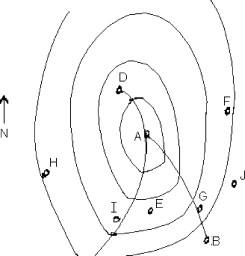
Of the stations listed below, which one most likely has the LEAST rain and cloud cover?
A) point A
B) point B
C) point I
D) point G
E) point H

Of the stations listed below, which one most likely has the LEAST rain and cloud cover?
A) point A
B) point B
C) point I
D) point G
E) point H

Unlock Deck
Unlock for access to all 114 flashcards in this deck.
Unlock Deck
k this deck
37
Compared to other types of fronts, the weather associated with a cold front usually:
A) is more violent but of shorter duration.
B) does not involve thunderstorms.
C) is less violent but of longer duration.
D) covers more area.
E) involves less precipitation.
A) is more violent but of shorter duration.
B) does not involve thunderstorms.
C) is less violent but of longer duration.
D) covers more area.
E) involves less precipitation.

Unlock Deck
Unlock for access to all 114 flashcards in this deck.
Unlock Deck
k this deck
38
Which of the stations listed below should have the highest temperature?
A) point A
B) point F
C) point J
D) point H
E) point E
A) point A
B) point F
C) point J
D) point H
E) point E

Unlock Deck
Unlock for access to all 114 flashcards in this deck.
Unlock Deck
k this deck
39

-Line A- B represents:
A) an occlusion.
B) a warm front.
C) a cold front.
D) an isobar.
E) none of these

Unlock Deck
Unlock for access to all 114 flashcards in this deck.
Unlock Deck
k this deck
40
The general term applied to warm air moving up over a colder air mass is:
A) cold front.
B) orographic lifting.
C) warm front.
D) overrunning.
A) cold front.
B) orographic lifting.
C) warm front.
D) overrunning.

Unlock Deck
Unlock for access to all 114 flashcards in this deck.
Unlock Deck
k this deck
41
All of the following are common locations for cyclongenesis EXCEPT for:
A) the Gulf of Mexico.
B) the Great Lakes region.
C) the North Pacific.
D) the eastern side of the Rocky Mountains.
A) the Gulf of Mexico.
B) the Great Lakes region.
C) the North Pacific.
D) the eastern side of the Rocky Mountains.

Unlock Deck
Unlock for access to all 114 flashcards in this deck.
Unlock Deck
k this deck
42
The energy of a mid- latitude cyclone comes mainly from:
A) Earth's interior.
B) clouds.
C) sinking cold air and rising warm air.
D) greenhouse effect.
E) ocean water.
A) Earth's interior.
B) clouds.
C) sinking cold air and rising warm air.
D) greenhouse effect.
E) ocean water.

Unlock Deck
Unlock for access to all 114 flashcards in this deck.
Unlock Deck
k this deck
43
The more violent nature of weather produced by a cold front can be attributed to which two factors?
A) the gradual slope and slow forward motion of the front
B) the steep slope and slow forward motion of the front
C) the gradual slope and fast forward motion of the front
D) the steep slope and fast forward motion of the front
A) the gradual slope and slow forward motion of the front
B) the steep slope and slow forward motion of the front
C) the gradual slope and fast forward motion of the front
D) the steep slope and fast forward motion of the front

Unlock Deck
Unlock for access to all 114 flashcards in this deck.
Unlock Deck
k this deck
44
Another common term for the wave cyclone is:
A) intertropical convergence zone.
B) tropical cyclone.
C) midlatitude cyclone.
D) polar- front cyclone.
A) intertropical convergence zone.
B) tropical cyclone.
C) midlatitude cyclone.
D) polar- front cyclone.

Unlock Deck
Unlock for access to all 114 flashcards in this deck.
Unlock Deck
k this deck
45
In 1921, J. Bjerknes and his co- authors published what came to be known as the polar front theory. Which one of the following statements is correct regarding this theory?
A) It was shown to be applicable only to winter storms in the Southern Hemisphere.
B) Although it was useful at the time, it is no longer a useful model.
C) The main features of the theory remain an important part of present- day meteorological thought.
D) The polar front theory was largely incorrect from the very beginning.
A) It was shown to be applicable only to winter storms in the Southern Hemisphere.
B) Although it was useful at the time, it is no longer a useful model.
C) The main features of the theory remain an important part of present- day meteorological thought.
D) The polar front theory was largely incorrect from the very beginning.

Unlock Deck
Unlock for access to all 114 flashcards in this deck.
Unlock Deck
k this deck
46
Which air mass type is generally found on the poleward side of a midlatitude cyclone?
A) cP
B) mP
C) mA
D) cT
E) mT
A) cP
B) mP
C) mA
D) cT
E) mT

Unlock Deck
Unlock for access to all 114 flashcards in this deck.
Unlock Deck
k this deck
47
A_________ cold front occurs when a strong high- pressure circulation brings colder, mP air into the eastern United States from the Atlantic Ocean.
A) backdoor
B) veering
C) reverse
D) anticyclonic
A) backdoor
B) veering
C) reverse
D) anticyclonic

Unlock Deck
Unlock for access to all 114 flashcards in this deck.
Unlock Deck
k this deck
48

-Refer to the diagram above. Which phase of the midlatitude cyclone's life cycle is associated with this type of front?
A) the anticyclonic phase
B) the mature phase
C) the birth and early development phase
D) the phase just prior to the dissipation of the storm

Unlock Deck
Unlock for access to all 114 flashcards in this deck.
Unlock Deck
k this deck
49
The wind direction in a low pressure system is:
A) from the north.
B) from the northwest.
C) from the south.
D) from the east.
E) dependent on your location relative to the storm center.
A) from the north.
B) from the northwest.
C) from the south.
D) from the east.
E) dependent on your location relative to the storm center.

Unlock Deck
Unlock for access to all 114 flashcards in this deck.
Unlock Deck
k this deck
50
 The process best illustrated in the diagram of a front above is:
The process best illustrated in the diagram of a front above is:A) occlusion.
B) convection.
C) overrunning.
D) convergence.

Unlock Deck
Unlock for access to all 114 flashcards in this deck.
Unlock Deck
k this deck
51
A warm front is said to exist when:
A) moving cold air overrides warmer air.
B) invading cold air pushes underneath warmer air.
C) advancing warm air overrides retreating cold air.
D) warm air pushes underneath cold air.
A) moving cold air overrides warmer air.
B) invading cold air pushes underneath warmer air.
C) advancing warm air overrides retreating cold air.
D) warm air pushes underneath cold air.

Unlock Deck
Unlock for access to all 114 flashcards in this deck.
Unlock Deck
k this deck
52
Why does occlusion lead to the demise of a mid- latitude cyclone?
A) The cold cP air mass driving the cyclone has warmed intensely.
B) The mT air mass has cooled through air mass modification.
C) All of the warm air has been lifted aloft.
D) The cold front stops progressing during occlusion.
A) The cold cP air mass driving the cyclone has warmed intensely.
B) The mT air mass has cooled through air mass modification.
C) All of the warm air has been lifted aloft.
D) The cold front stops progressing during occlusion.

Unlock Deck
Unlock for access to all 114 flashcards in this deck.
Unlock Deck
k this deck
53
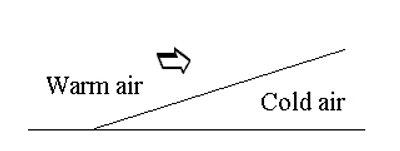
The type of front shown in the diagram above is:
A) a warm front.
B) an occluded front.
C) a cold front.
D) a stationary front.

Unlock Deck
Unlock for access to all 114 flashcards in this deck.
Unlock Deck
k this deck
54
The life cycle of a midlatitude cyclone generally has ______stages.
A) ten
B) one
C) two
D) six
E) four
A) ten
B) one
C) two
D) six
E) four

Unlock Deck
Unlock for access to all 114 flashcards in this deck.
Unlock Deck
k this deck
55
If a warm front is approaching, you can expect:
A) falling temperatures.
B) clearing skies.
C) rising temperatures.
D) calm winds.
A) falling temperatures.
B) clearing skies.
C) rising temperatures.
D) calm winds.

Unlock Deck
Unlock for access to all 114 flashcards in this deck.
Unlock Deck
k this deck
56
Compared to warm fronts, cold fronts have:
A) the same gradient and a faster advance rate.
B) a shallower gradient and a slower advance rate.
C) a steeper gradient and a faster advance rate.
D) a shallower gradient and the same advance rate.
E) the same gradient and the same advance rate.
A) the same gradient and a faster advance rate.
B) a shallower gradient and a slower advance rate.
C) a steeper gradient and a faster advance rate.
D) a shallower gradient and the same advance rate.
E) the same gradient and the same advance rate.

Unlock Deck
Unlock for access to all 114 flashcards in this deck.
Unlock Deck
k this deck
57
A wind shift in a counterclockwise direction, as from east to north, is termed____ wind shift.
A) frontal
B) veering
C) backing
D) cyclonic
A) frontal
B) veering
C) backing
D) cyclonic

Unlock Deck
Unlock for access to all 114 flashcards in this deck.
Unlock Deck
k this deck
58
A mature mid- latitude cyclone cloud pattern most closely resembles what when viewed from a satellite?
A) a starfish
B) a circle
C) a comma
D) an octopus
A) a starfish
B) a circle
C) a comma
D) an octopus

Unlock Deck
Unlock for access to all 114 flashcards in this deck.
Unlock Deck
k this deck
59
On a weather map,__________ fronts are shown with blue triangular points along a blue line.
A) occluded
B) warm
C) stationary
D) cold
A) occluded
B) warm
C) stationary
D) cold

Unlock Deck
Unlock for access to all 114 flashcards in this deck.
Unlock Deck
k this deck
60
The weather most typically associated with a blocking high is:
A) repeated storms that can lead to flooding in one part of the country.
B) severe thunderstorms and tornado outbreaks.
C) drought for the entire country.
D) high pressure and clear skies across the entire United States.
A) repeated storms that can lead to flooding in one part of the country.
B) severe thunderstorms and tornado outbreaks.
C) drought for the entire country.
D) high pressure and clear skies across the entire United States.

Unlock Deck
Unlock for access to all 114 flashcards in this deck.
Unlock Deck
k this deck
61
Each of the statements refers to the approach or to the passage of a front. If the statement refers to the approach of a typical cold front, use the letter A for your answer. If the statement refers to the approach or passage of a typical warm front, use the letter B. If the statement applies to both, answer with letter C.
-Winds shift from southwest to northwest
-Winds shift from southwest to northwest

Unlock Deck
Unlock for access to all 114 flashcards in this deck.
Unlock Deck
k this deck
62
The development of major winter storms in the midwest depends strongly on:
A) air mass contrasts.
B) wind speed near the surface.
C) rainfall amounts during the previous fall.
D) amount of snow already on the ground.
E) wind speed aloft.
A) air mass contrasts.
B) wind speed near the surface.
C) rainfall amounts during the previous fall.
D) amount of snow already on the ground.
E) wind speed aloft.

Unlock Deck
Unlock for access to all 114 flashcards in this deck.
Unlock Deck
k this deck
63
Outside of the Great Lakes region, rising barometric pressure and a wind from the northwest generally mean that:
A) severe weather is approaching.
B) rain will occur within the next 3 hours.
C) a blizzard is approaching.
D) skies will clear.
A) severe weather is approaching.
B) rain will occur within the next 3 hours.
C) a blizzard is approaching.
D) skies will clear.

Unlock Deck
Unlock for access to all 114 flashcards in this deck.
Unlock Deck
k this deck
64
Each of the statements refers to the approach or to the passage of a front. If the statement refers to the approach of a typical cold front, use the letter A for your answer. If the statement refers to the approach or passage of a typical warm front, use the letter B. If the statement applies to both, answer with letter C.
-Severe thunderstorm/tornado
-Severe thunderstorm/tornado

Unlock Deck
Unlock for access to all 114 flashcards in this deck.
Unlock Deck
k this deck
65
Severe weather, including tornadoes, is most often associated with a ______front.

Unlock Deck
Unlock for access to all 114 flashcards in this deck.
Unlock Deck
k this deck
66
Why is the weather associated with a cold front usually of short duration?

Unlock Deck
Unlock for access to all 114 flashcards in this deck.
Unlock Deck
k this deck
67
Each of the statements refers to the approach or to the passage of a front. If the statement refers to the approach of a typical cold front, use the letter A for your answer. If the statement refers to the approach or passage of a typical warm front, use the letter B. If the statement applies to both, answer with letter C.
-Warm air is lifted over cold air
-Warm air is lifted over cold air

Unlock Deck
Unlock for access to all 114 flashcards in this deck.
Unlock Deck
k this deck
68
Thunderstorms can be generated when a cT air mass meets an mT air mass and creates a frontal boundary called a:
A) dryline.
B) humidity front.
C) cold front.
D) warm front.
A) dryline.
B) humidity front.
C) cold front.
D) warm front.

Unlock Deck
Unlock for access to all 114 flashcards in this deck.
Unlock Deck
k this deck
69
What cloud type is often seen as the first sign of an approaching warm front?

Unlock Deck
Unlock for access to all 114 flashcards in this deck.
Unlock Deck
k this deck
70
What feature of the upper- level wind pattern must exist for the origin and development of a surface low?

Unlock Deck
Unlock for access to all 114 flashcards in this deck.
Unlock Deck
k this deck
71
Which location is most likely to be experiencing thunderstorms?
A) F
B) I
C) H
D) G
A) F
B) I
C) H
D) G

Unlock Deck
Unlock for access to all 114 flashcards in this deck.
Unlock Deck
k this deck
72
Which of the following lists the stages of the mid- latitude cyclone life cycle in the proper order?
A) cyclogenesis, open- wave, dissipation, occlusion
B) open- wave, occlusion, cyclogenesis, dissipation
C) occlusion, dissipation, open- wave, cyclogenesis
D) cyclogenesis, open- wave, occlusion, dissipation
A) cyclogenesis, open- wave, dissipation, occlusion
B) open- wave, occlusion, cyclogenesis, dissipation
C) occlusion, dissipation, open- wave, cyclogenesis
D) cyclogenesis, open- wave, occlusion, dissipation

Unlock Deck
Unlock for access to all 114 flashcards in this deck.
Unlock Deck
k this deck
73
On a weather map, a line with blue triangles on one side and red semicircles on the other represents:
A) an occluded front.
B) a cold front.
C) a warm front.
D) a stationary front.
A) an occluded front.
B) a cold front.
C) a warm front.
D) a stationary front.

Unlock Deck
Unlock for access to all 114 flashcards in this deck.
Unlock Deck
k this deck
74
Each of the statements refers to the approach or to the passage of a front. If the statement refers to the approach of a typical cold front, use the letter A for your answer. If the statement refers to the approach or passage of a typical warm front, use the letter B. If the statement applies to both, answer with letter C.
-An "invading" cP air mass
-An "invading" cP air mass

Unlock Deck
Unlock for access to all 114 flashcards in this deck.
Unlock Deck
k this deck
75
Each of the statements refers to the approach or to the passage of a front. If the statement refers to the approach of a typical cold front, use the letter A for your answer. If the statement refers to the approach or passage of a typical warm front, use the letter B. If the statement applies to both, answer with letter C.
-Long lasting, steady rainfall
-Long lasting, steady rainfall

Unlock Deck
Unlock for access to all 114 flashcards in this deck.
Unlock Deck
k this deck
76
Describe the favored locations for surface cyclones and anticyclones with respect to the upper- level ridges and troughs.

Unlock Deck
Unlock for access to all 114 flashcards in this deck.
Unlock Deck
k this deck
77
What type of occluded front is most common along the west coasts of continents?

Unlock Deck
Unlock for access to all 114 flashcards in this deck.
Unlock Deck
k this deck
78
Which of these best describes the reason most high pressure systems bring clear skies?
A) cold air near the surface
B) sinking air aloft
C) rising air aloft
D) high temperatures aloft
E) low temperatures aloft
A) cold air near the surface
B) sinking air aloft
C) rising air aloft
D) high temperatures aloft
E) low temperatures aloft

Unlock Deck
Unlock for access to all 114 flashcards in this deck.
Unlock Deck
k this deck
79
When the center of a mature wave cyclone passes to the south, you should expect:
A) thunderstorms.
B) rising pressure and fair weather.
C) winds shifting from east to north and heavy precipitation.
D) to experience a veering wind shift.
A) thunderstorms.
B) rising pressure and fair weather.
C) winds shifting from east to north and heavy precipitation.
D) to experience a veering wind shift.

Unlock Deck
Unlock for access to all 114 flashcards in this deck.
Unlock Deck
k this deck
80
Each of the statements refers to the approach or to the passage of a front. If the statement refers to the approach of a typical cold front, use the letter A for your answer. If the statement refers to the approach or passage of a typical warm front, use the letter B. If the statement applies to both, answer with letter C.
-Pressure falls when front approaches
-Pressure falls when front approaches

Unlock Deck
Unlock for access to all 114 flashcards in this deck.
Unlock Deck
k this deck



